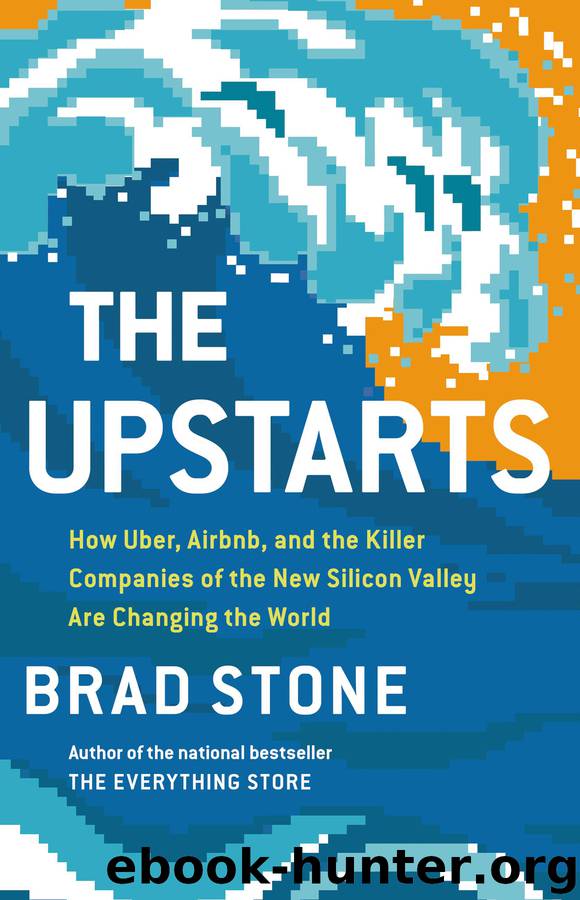The Upstarts by Brad Stone

Author:Brad Stone
Language: eng
Format: epub, mobi
Tags: Business & Economics / Entrepreneurship, Technology & Engineering / General, Business & Economics / Industries / Computers & Information Technology, Business & Economics / Corporate & Business History
Publisher: Little, Brown and Company
Published: 2017-01-30T16:00:00+00:00
That summer, Uber considered closely the lessons of its Uber Taxi experiment. In Chicago it had put a cheaper ride next to a pricier one, and, according to internal data, both businesses flourished. Riders, not surprisingly, responded favorably to cheaper rides.
So if Uber’s brand was versatile enough to accommodate the germ-infested backseats of yellow cabs, what else could it include? Kalanick and his colleagues produced two answers. One was a fleet of luxury SUVs, to be used by larger parties, that would cost more than traditional Uber black cars. The second was a fleet of four-door hybrids, an option that would cost the rider less than the original Uber offering. The name of the service, UberX, was simply the best the company could come up with. “It was a placeholder. We called it UberX because we couldn’t figure out a name for it,” says Uber’s product chief at the time, Mina Radhakrishnan, who adds that Uber Green and Uber Eco were briefly considered and rejected.
Now, an important clarification: Unlike Lyft and Sidecar, the so-called ridesharing companies that were at that very moment making their debuts in San Francisco, the original UberX accommodated only professional drivers who held taxi licenses. Kalanick envisioned a fleet of black Toyota Priuses to be driven by the same types of licensed chauffeurs who were behind the wheels of other Uber vehicles.
Uber introduced these options on July 4, 2012, with a blog post that promised “Choice is a beautiful thing.”11 Kalanick told the New York Times that day, “This is the first big step Uber is taking to go to the masses.”12 The SUVs and hybrids were set for San Francisco, New York, and, soon, Chicago—and Washington, DC.
Uber’s business was now growing in DC by 30 to 40 percent each month, surprising even its managers.13 When Rachel Holt started in Washington, Graves had asked her to get the company’s business in the city to $7 million in gross bookings by the end of the year. She hit that goal by April. “I thought, Gee, this is going well,” she says. But the celebration was short-lived. Uber’s growing popularity and plans to roll out UberX were about to provoke another five months of bare-knuckle political brawls.
After ineffectual discussions between Uber execs and Washington’s attorney general, the issue of Uber’s regulatory status fell into the lap of the DC city councilwoman Mary Cheh, the chairperson of the Committee on Transportation and the Environment. Cheh, sixty-two, was a graduate of Harvard Law and a Democrat who had struggled for years to drag anachronistic DC cabs into the modern age. “Even while Uber was coming around, I was in process of trying to reform the taxicab industry which was in the twentieth, maybe the nineteenth, century,” she says. She was also a pragmatist who sought peaceful compromise between many of the powerful local taxi interests in what was turning into a radioactive topic. That spring she sent a letter to Ron Linton and the DC Taxicab Commission, asking them to
Download
This site does not store any files on its server. We only index and link to content provided by other sites. Please contact the content providers to delete copyright contents if any and email us, we'll remove relevant links or contents immediately.
| Consulting | Entrepreneurship |
| Franchises | Home Based |
| Marketing | New Business Enterprises |
| Nonprofit Organizations & Charities |
Pioneering Portfolio Management by David F. Swensen(5641)
Zero to One by Peter Thiel(4880)
Man-made Catastrophes and Risk Information Concealment by Dmitry Chernov & Didier Sornette(4796)
The Motivation Myth by Jeff Haden(4564)
The Miracle Morning by Hal Elrod(3948)
Elon Musk by Ashlee Vance(3480)
The Art of Persistence: Stop Quitting, Ignore Shiny Objects and Climb Your Way to Success by Michal Stawicki(3378)
Unlabel: Selling You Without Selling Out by Marc Ecko(3013)
Urban Outlaw by Magnus Walker(2970)
Delivering Happiness by Tony Hsieh(2947)
Purple Cow by Seth Godin(2723)
Mastering Bitcoin: Programming the Open Blockchain by Andreas M. Antonopoulos(2539)
The Content Trap by Bharat Anand(2511)
The Marketing Plan Handbook: Develop Big-Picture Marketing Plans for Pennies on the Dollar by Robert W. Bly(2434)
The Power of Broke by Daymond John(2402)
The Airbnb Story by Leigh Gallagher(2395)
Applied Empathy by Michael Ventura(2347)
Radical Candor by Kim Scott(2256)
Keep Going by Austin Kleon(2186)
